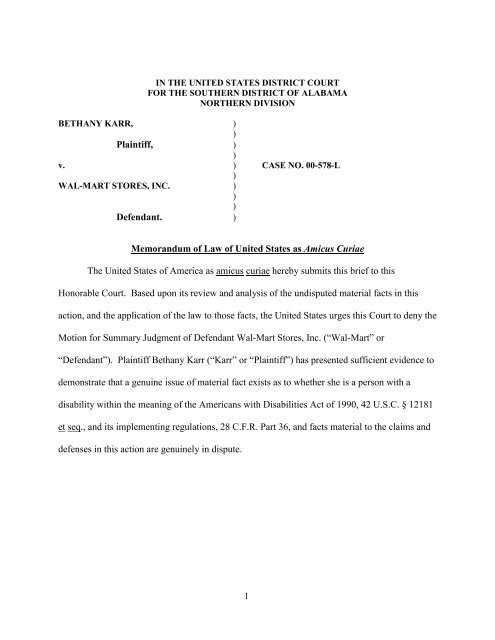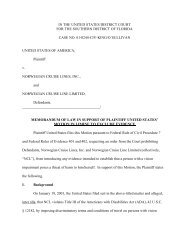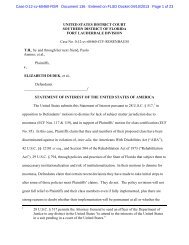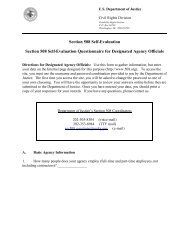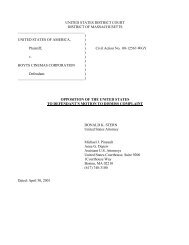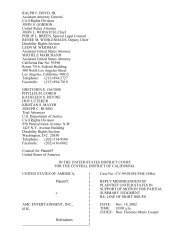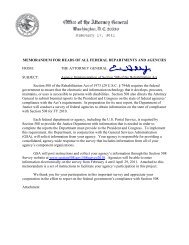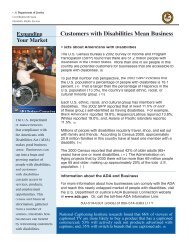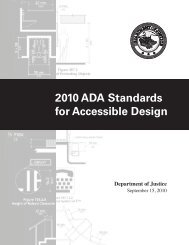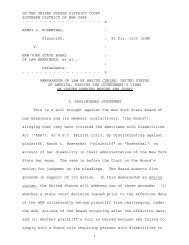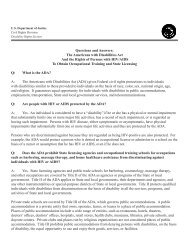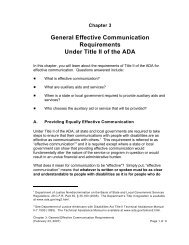Karr v. Wal-Mart Stores, Inc. - ADA.gov
Karr v. Wal-Mart Stores, Inc. - ADA.gov
Karr v. Wal-Mart Stores, Inc. - ADA.gov
Create successful ePaper yourself
Turn your PDF publications into a flip-book with our unique Google optimized e-Paper software.
IN THE UNITED STATES DISTRICT COURTFOR THE SOUTHERN DISTRICT OF ALABAMANORTHERN DIVISIONBETHANY KARR, ))Plaintiff, ))v. ) CASE NO. 00-578-L)WAL-MART STORES, INC. )))Defendant. )Memorandum of Law of United States as Amicus CuriaeThe United States of America as amicus curiae hereby submits this brief to thisHonorable Court. Based upon its review and analysis of the undisputed material facts in thisaction, and the application of the law to those facts, the United States urges this Court to deny theMotion for Summary Judgment of Defendant <strong>Wal</strong>-<strong>Mart</strong> <strong>Stores</strong>, <strong>Inc</strong>. (“<strong>Wal</strong>-<strong>Mart</strong>” or“Defendant”). Plaintiff Bethany <strong>Karr</strong> (“<strong>Karr</strong>” or “Plaintiff”) has presented sufficient evidence todemonstrate that a genuine issue of material fact exists as to whether she is a person with adisability within the meaning of the Americans with Disabilities Act of 1990, 42 U.S.C. § 12181et seq., and its implementing regulations, 28 C.F.R. Part 36, and facts material to the claims anddefenses in this action are genuinely in dispute.1
III. STANDARD FOR SUMMARY JUDGMENTOn a motion for summary judgment, the court is to construe the evidence and factualinferences arising therefrom in the light most favorable to the nonmoving party. See Adickes v.S.H. Kress & Co., 398 U.S. 144, 157, 90 S.Ct. 1598, 26 L.Ed.2d 142 (1970). Summaryjudgment can be entered on a claim only if it is shown "that there is no genuine issue as to anymaterial fact and that the moving party is entitled to judgment as a matter of law." Fed.R.Civ.P.56(c). As the Supreme Court has explained the summary judgment standard:[T]he plain language of Rule 56(c) mandates the entry of summary judgment, afteradequate time for discovery and upon motion, against a party who fails to make ashowing sufficient to establish the existence of an element essential to that party's case,and on which that party will bear the burden of proof at trial. In such a situation, there canbe no 'genuine issue as to any material fact,' since a complete failure of proof concerningan essential element of the nonmoving party's case necessarily renders all other factsimmaterial.Celotex Corp. v. Catrett, 477 U.S. 317, 322-23, 106 S. Ct. 2548, 91 L.Ed.2d 265 (1986) (citingFed.R.Civ.P. 56(c)). The United States submits that, as set forth below, Plaintiff has made ashowing sufficient to demonstrate the existence of a genuine issue of material fact as to whethershe is a person with a disability within the meaning of the <strong>ADA</strong>.IV. APPLICABLE STATUTORY AND REGULATORY SCHEMEThe <strong>ADA</strong> defines a “disability” as “(A) a physical or mental impairment thatsubstantially limits one or more of the major life activities of such individual; (B) a record ofsuch impairment; or (C) being regarded as having such an impairment.” 42 U.S.C. § 12102(2);28 C.F.R. § 36.104. “Physical or mental impairment” is defined as “any mental orpsychological disorder such as ... emotional or mental illness.” 28 C.F.R. § 36.104. “Major lifeactivities” include, but are not limited to, “functions such as caring for one’s self, performing3
manual tasks, walking, seeing, hearing, speaking, breathing, learning, and working.” Id.Furthermore, “[a] person is considered an individual with a disability ... when the individual’simportant life activities are restricted as to the conditions, manner, or duration under which theycan be performed in comparison to most people.” 28 C.F.R. Part 36, App. B. § 36.104.V. FACTUAL BACKGROUNDPlaintiff <strong>Karr</strong> is a twenty-four (24) year old adult resident citizen of the State of Alabama.Complaint 4. <strong>Karr</strong> was diagnosed with a severe form of Tourette Syndrome (“TS”) andObsessive Compulsive Disorder (“OCD”) when she was approximately twelve (12) years old.Plaintiff’s Exhibit (“Pl.’s Ex.”) No. 25 at 1, 2. TS is an inherited, neurological disordercharacterized by repeated and involuntary body movements and uncontrollable vocal sounds.National Institute of Neurological Disorders and Stroke “Tourette Syndrome Fact Sheet” (“TSFact Sheet”), http://www.ninds.nih.<strong>gov</strong>/health_and_medical/pubs/tourette_syndrome.htm. <strong>Karr</strong>also exhibits one of the most socially stigmatizing symptoms of TS called coprolalia, theinvoluntary outburst of obscene words or socially inappropriate and derogatory remarks. Id.<strong>Karr</strong>’s coprolalia manifests itself through her involuntary use of the words “fuck,” “nigger,”“shit,” and “bitch.” Deposition of Bethany <strong>Karr</strong> (“<strong>Karr</strong> Dep.”) at 28–29. <strong>Karr</strong>’s involuntaryoutbursts, such as the ones presented in this case, are especially pronounced because of herecholalia, which is characterized by a compulsive repetition of words. An ordinary observermight recognize that <strong>Karr</strong>’s vocal tics are unintentional and involuntary behavior because theyare uttered in a louder tone and different vocal pitch than normal conversational speech. TS FactSheet, http://www.ninds.nih.<strong>gov</strong>/health_and_medical/pubs/tourette_syndrome.htm. In addition,<strong>Karr</strong> experiences other symptoms of TS such as exhopraxia, which causes her to repeat words4
and phrases that she hears, innerpraxia, which occasionally causes her to make profane gestureswith the middle fingers of her hands, and motor tics which cause marked extreme movements ofher face, arms, and legs. Pl.’s Ex. No. 21 and No. 1 at 31, lns. 34-36. <strong>Karr</strong>’s vocal and motortics are virtually constant. Id. at 2, 3 and 5.<strong>Karr</strong> also suffers from Obsessive Compulsive Disorder (“OCD”), which is an associatedbehavior of TS which causes <strong>Karr</strong> to feel that something must be done over and over again andin a particular way. <strong>Karr</strong> Dep. at 32. For instance, her OCD causes <strong>Karr</strong> to do things like countmoney or lock doors over and over again. Id., lns. 10-14. In addition, <strong>Karr</strong>’s OCD causes her toexperience repetitive unwanted and bothersome thoughts. Combined with TS, OCD has led toher decreased ability to concentrate for sustained periods of time, as well as her inability tomaintain normal sleep patterns. Physicians have attempted to treat <strong>Karr</strong>’s TS and OCD withnumerous medications without success. Pl.’s Ex. No. 21 at 1, 6; Pl.’s Ex. No. 23 at 1, 1; Pl.’sEx. No. 25 at 1, 4. In fact, as she’s grown older her symptoms have only worsened. Pl.’s Ex.No. 21 at 1 2; <strong>Karr</strong> Dep. at 31, ln. 4.VI. ARGUMENTPlaintiff has produced evidence sufficient to create a genuine question of material fact asto whether, as a result of her TS and OCD, she is a person with a disability who is substantiallylimited in the major life activities of interacting with others and working. 1The term "disability"1 Although <strong>Karr</strong> alleges that she is substantially limited in several major life activities,see Plaintiff’s Opposition to Defendant’s Motion for Summary Judgment (“Pl.’s Br.”) at 15-16and 21-23, a plaintiff need only demonstrate that his or her disability affects one major lifeactivity. 42 U.S.C. § 12102(2)(A). Therefore, instead of addressing each major life activity thatis substantially limited by Plaintiff’s TS, the United States chooses to focus its brief on the majorlife activities of interacting with others and working.5
with respect to an individual is defined under the <strong>ADA</strong> as “a physical or mental impairment thatsubstantially limits one or more of the major life activities of such individual.” 42 U.S.C. §12102(2)(a); 28 C.F.R. § 36.104. 2The Supreme Court has articulated a three-step inquiry fordetermining whether an impairment substantially limits a major life activity so as to constitute adisability under the <strong>ADA</strong>. See Bragdon v. Abbott, 524 U.S. 624, 631, 118 S. Ct. 2196, 2202,141 L.Ed.2d 540 (1998). First, the court must ascertain whether plaintiff has a physical ormental "impairment." Next, the court must identify whether any “major life activities” areimpacted by that impairment. Finally, the court must determine whether the impairment"substantially limits" any major life activity. Id.Applying this standard to Plaintiff’s TS and OCD, Plaintiff has an impairment thatsubstantially limits a major life activity. The phrase “physical or mental impairment” includesany “physiological disorder or condition” that affects the neurological system or “any mental orpsychological disorder such as ... emotional or mental illness.” 28 C.F.R. § 36.104. TouretteSyndrome is a neurological impairment characterized by motor and verbal tics and coprolalia.Purcell v. Pennsylvania Dep’t of Corrs., 1998 WL 10236 (E.D. Pa. 1998). It is undisputed thatPlaintiff’s TS and OCD are impairments within the meaning of the <strong>ADA</strong>. See Defendant’s Briefin Support of Motion for Summary Judgment (“Def.’s Br.”) at 9.The next inquiry is whether Plaintiff’s impairment substantially limits a major lifeactivity. Although not exhaustive, Title III’s implementing regulations describe “major life2 The United States will only address whether Plaintiff has an actual disability under 42U.S.C. § 12102(2)(A), even though Plaintiff has presented evidence on which a jury couldreasonably find that Defendant “regarded” her as a person with a disability, and that she has a“record of” disability under 42 U.S.C. § 12102(2)(B) and (C). See Pl.’s Br. at 19-20 and 23-24.6
activities” as “functions such as caring for one’s self, performing manual tasks, walking, seeing,hearing, speaking, breathing, learning, and working.” 28 C.F.R. § 36.104. In addition, the EqualEmployment Opportunity Commission’s Enforcement Guidance on the Americans withDisabilities Act and Psychiatric Disabilities 5 (March 25, 1997) lists “interacting with others” asa major life activity. Plaintiff alleges that, among other things, she is substantially limited in themajor life activities of interacting with others and working. Courts addressing the issue ofwhether a person who has TS and OCD should be considered a person with a disability withinthe meaning of the <strong>ADA</strong> have held that a trier of fact could reasonably conclude that anindividual who has these conditions is in fact disabled. For instance, in Purcell, 1998 WL 10236at *8, the court held that the plaintiff who, like <strong>Karr</strong>, had TS and OCD, was substantially limitedin the major life activity of interacting with others as a result of his inability to communicatewith others for extended periods of time. 3In light of the evidence presented in this case of theextreme symptoms and uncontrollable nature of <strong>Karr</strong>’s TS and OCD, a genuine issue of materialfact exists as to whether she is a person with a disability.3 Although not addressing the major life activities of interacting with others or working,Lanci v. Arthur Andersen, LLP, 2000 WL 329226, *4 (S.D.N.Y. 2000), is another case in whichthe court held that a plaintiff with TS and OCD could be considered a person with a disabilitywithin the meaning of the <strong>ADA</strong>. In Lanci, the court determined that the plaintiff’s “intrusivethoughts,” combined with the effects of his TS and OCD, “significantly restricted his ability tothink and concentrate.” (emphasis in original). The court reasoned that plaintiff’s acutesymptoms, although not regular, could be expected to reoccur and lasted long enough to fallwithin the <strong>ADA</strong>’s definition of disability. Id. at *5.7
A. A genuine issue of material fact exists as to whether Plaintiff is substantiallylimited in the major life activity of interacting with othersInteracting with others is a major life activity within the meaning of the <strong>ADA</strong>. Forinstance, in McAlindin v. County of San Diego, 192 F.3d 1226, 1234 (9 th Cir. Sept. 16, 1999,amended Jan. 18, 2000), cert. denied, U. S. , 120 S. Ct. 2689, 147 L. Ed. 2d 961 (2000),the plaintiff had been diagnosed with anxiety, panic, and somatoform disorders that caused himto withdraw from family members and public places. The Ninth Circuit reasoned that “becauseinteracting with others is an essential, regular function, like walking and breathing, it easily fallswithin the definition of ‘major life activity.’” The court qualified its holding, explaining that“[r]ecognizing interacting with others as a major life activity of course does not mean that anycantankerous person will be deemed substantially limited in a major life activity. Mere troublegetting along with coworkers is not sufficient to show a substantial limitation.” Id. The factorsthat the court considered to be determinative of McAlindin’s limitation were clinical findingsindicating a pattern of withdrawal from public places and social settings, as well as the severityof the limitation “when compared to the ability of ‘the average person in the generalpopulation.’” Id. (citations omitted). 4Furthermore, the court held that “a plaintiff must show that4 Other courts have held that interacting with others is a major life activity. See Soileauv. Guilford of Maine, <strong>Inc</strong>., 105 F.3d 12, 15 (1 st Cir. 1997) (assumed that interacting with others isa major life activity on specific facts, but held that particular effects of plaintiff’s impairment didsubstantially limit his ability to interact with others); Steele v. Thiokol Corp., 241 F.3d 1248,1255 (10 th Cir. 2001) (same); Garvey v. Jefferson Smurfit Corp., 2000 WL 1586077, *3 (E.D.Pa. 2000) (finding that a jury could conclude that plaintiff with severe form of hypertension wassubstantially limited in major life activity of interacting with others); Zale v. Sikorsky AircraftCorp., 2000 WL 306943 (D. Conn. 2000) (recognizing the major life activity of interaction withothers); Purcell, 1998 WL 10236, * 8 (ability to communicate for extended period of timeaffected major life activity of interacting with others); Sherback v. Wright Automotive Group,987 F. Supp. 433, 438 (W.D. Penn. 1997) (recognizing major life activity of interaction with8
his ‘relations with others were characterized on a regular basis by severe problems, for example,consistently high levels of hostility, social withdrawal, or failure to communicate whennecessary.’” Id. quoting EEOC Enforcement Guidance on the Americans with Disabilities Actand Psychiatric Disabilities 5 (March 25, 1997).The effects of <strong>Karr</strong>’s TS and OCD on her ability to interact with others are more severethan those found in McAlindin. <strong>Karr</strong>’s TS and OCD are debilitating conditions with respect totheir constant effects on her ability to interact with others. As discussed in Part V., supra,Plaintiff has uncontrollable and nearly constant motor tics and vocalizations, including profanity,racial slurs, obscene gestures, and other involuntary actions involving her hands and face. Thesesymptoms result in a “failure to communicate when necessary,” and severely inhibit her abilityto enter into public or social settings. Pl.’s Ex. No. 16 at 2. <strong>Karr</strong> experiences severe anxiety inpublic places stemming from her fear of the way in which she will be perceived. Id. People whoencounter <strong>Karr</strong> openly mock her, stare at her, and misperceive her coprolalia and motor tics as asign of disrespect or hatred. Pl.’s Ex. No. 16 at 20, No. 17 at 15, and No. 13 at 9.The facts of this case are illustrative of the difficulties <strong>Karr</strong> faces as a result of her TS andOCD any time that she attempts to interact with others who do not understand her disability.Often, people <strong>Karr</strong> encounters in public are offended by the symptoms of her disability. Pl.’s Ex.Nos. 16 at 20, 17 at 15, and 13 at 8-9. As a result, Plaintiff’s interactions with others are“characterized on a regular basis by severe problems” such as “a pattern of withdrawal fromothers). Krocka v. Bransfield, 969 F. Supp. 1073, 1084 (N.D. Ill. 1997), aff’d on other groundssub nom., Krocka v. City of Chicago, 203 F.3d 507 (7 th Cir. 2000) (plaintiff could establishdisability under <strong>ADA</strong> by demonstrating that abilities to function generally and to interact withothers, and therefore to work, were substantially limited).9
public places.” McAlindin, 192 F.3d at 1235. <strong>Karr</strong> only socializes with her roommate and herfamily because, in her words, “they accept [her] Tourette’s Syndrome without berating [her].”Application for Disability Benefits, Daily Activities Questionnaire, Dec. 1995, Pl.’s Ex. No. 20at 2, 16; Pl.’s Ex. No. 16. As in McAlindin, clinical findings indicate that <strong>Karr</strong>’s TS and OCDcause her pattern of withdrawal from public places and social settings. One doctor whoevaluated Plaintiff explained that she has “near constant coprolalia and vocal tics, and [that] it isfairly obvious as to why [Plaintiff] is not only disabled, but unable to be in public.” Pl.’s Ex. No.21 at 2, 11. Thus, the severity of the limitations on <strong>Karr</strong>’s ability to interact with others ascompared with the average person in the general population is evident.Furthermore, <strong>Karr</strong>’s limitations with respect to interacting with others are also moresevere than those experienced by the plaintiff in Purcell. In Pucell, the court held that a jurycould reasonably find that plaintiff’s TS and OCD substantially limited the major life activity ofinteracting with others even though Purcell had the ability to temporarily suppress his verbal andmotor tics while interacting with others. In contrast, <strong>Karr</strong>’s TS and OCD are so extreme that sheis unable to exercise any similar degree of control over her vocal and motor tics. Pl.’s Ex. No.25 at 1, 2-3. Defendant asserts that because people can “understand what <strong>Karr</strong> is saying,” shecan therefore communicate effectively. However, the court in Purcell made clear that theplaintiff’s ability to suppress his verbal and motor tics while interacting with others, and as aresult, communicate with others on discrete occasions, did not disprove the fact that Purcell’s TSsubstantially limited the major life activity of interacting with others. Id. at *7. Further evidenceof the severity of <strong>Karr</strong>’s coprolalia is found in her deposition transcript which is markedthroughout by her use of profanity. The deposition transcript does not portray the extent to10
which <strong>Karr</strong>’s motor tics affect her ability to interact with others. <strong>Karr</strong>’s use of profane andnonsensical words and sounds, as well as her profound body tics, are generally viewed associally unacceptable behavior, thus severely impairing her ability to interact with others in anypublic setting. Therefore, Plaintiff has presented sufficient evidence to demonstrate a genuineissue of material fact as to whether she is substantially limited in the major life activity ofinteracting with others.B. A genuine issue of material fact exists as to whether Plaintiff is substantiallylimited in the major life activity of workingIn addition to interacting with others, Plaintiff has presented sufficient evidence of hersubstantial limitation in the major life activity of working to survive summary judgment.To be considered substantially limited in the major life activity of working a person must beprecluded from performing “‘either a class of jobs or a broad range of jobs in various classes ascompared to the average person having comparable training, skills and abilities.’” Williamson v.Int’l Paper Co., 85, F. Supp. 2d 1184, 1194 (11 th Cir. 2000) (quoting 29 C.F.R. § 1630.2(j)(3)(i)).“[W]hether a plaintiff is substantially limited in the major life activity of working is determinedby comparing his ability to perform jobs with the ability of a person without physical limitationswho has a comparable education, job skills, and talent.” Mullins v. Crowell, 228 F.3d 1305, 1314(11 th Cir. 2000). An analysis of whether an individual is substantially limited in the major lifeactivity of working may include consideration of:the geographical area to which the individual has reasonable access, the job from whichthe individual has been disqualified because of an impairment, and the number and typesof jobs using and not using similar training, knowledge, skills, or abilities within thatgeographical area, from which the individual is also disqualified because of theimpairment.11
Id. at 1315. Expert vocational evidence is not necessary to establish that a person is substantiallylimited in the major life activity of working. A plaintiff can testify from his or her own jobsearch experience whether other jobs that he or she could perform were available in thegeographical area. Mullins, 228 F.3d at 1314 n.8. Furthermore, a plaintiff presents sufficientevidence to survive a motion for summary judgment on the issue of being substantially limited inthe major life activity of working if he or she presents medical evidence, such as a physician’sopinion, of his or her inability to work in either a class of jobs or a broad range of jobs in variousclasses. Pritchard v. Southern Co. Servs., 92 F.3d 1130, 1134 (11 th Cir. 1996).Defendant’s contention that working is not a major life activity within the meaning of the<strong>ADA</strong> is unfounded. See Def.’s Br. at 11. The Eleventh Circuit has specifically addressed thisissue, explaining, “the Supreme Court did not hold [in Sutton v. United Air Lines, <strong>Inc</strong>., 572 U.S.471, 119 S. Ct. 2139, 144 L.Ed.2d 450 (1999),] that working was not a ‘major life activity.’Accordingly, our precedent treating working as a ‘major life activity’ is still valid, and thedistrict court erred by interpreting the [<strong>ADA</strong>] contrary to our precedent.” Mullins, 228 F.3d at1313. See also Reed v. Heil Co., 206 F.3d 1055, 1061 (11 th Cir. 2000) (“A physical or mentalimpairment qualifies as a disability under the <strong>ADA</strong> if it substantially limits a major life activity,such as working.”). Therefore, working is a major life activity within the meaning of the <strong>ADA</strong>.Plaintiff can demonstrate that she is substantially limited in a broad range of jobs, such asany that require frequent interaction with the public, and a class of jobs, such as jobs in theservice industry. As Defendant points out in its brief, Plaintiff is a well educated and intelligentindividual who graduated from her high school at the top of her class and who has completedcourses to become a certified nursing assistant (“CNA”). Def.’s Br. at 18; <strong>Karr</strong> Dep. at 14, ln. 1912
and at 8, lns. 15-16. Most individuals with Plaintiff’s level of education and training could beexpected to have a record of consistent and ongoing employment. However, despite hereducation, Plaintiff has been unemployed and receiving social security disability benefits since1997. Furthermore, <strong>Karr</strong> has held only three (3) jobs since her high school graduation, none ofwhich she held for more than one (1) year. <strong>Karr</strong> Dep. at 15-25. Plaintiff was “let go” from herlast job were she worked as a CNA because of the effects of her TS and OCD. Pl.’s Ex. No. 25at 1, 2; <strong>Karr</strong> Dep. at 22, ln. 8; Pl.’s Ex. No. 20 at 3, 26-27. Plaintiff stated in her applicationfor social security disability benefits that the pressures of work make her TS and OCD moresevere. Pl.’s Ex. No. 20 at 3, 26-27.<strong>Karr</strong>’s physicians’ description of her diagnosis and the employment difficulties that sheexperienced as a result of her diagnosis is sufficient evidence to survive a motion for summaryjudgment on the issue of whether her impairment substantially limited the major life activity ofworking. For instance, in Pritchard, the plaintiff, who was diagnosed with depression anddysautonomia, had symptoms of profound fatigue, lack of interest and energy, difficultysleeping, communicating, and concentrating, among other things. 92 F.3d at 1132. TheEleventh Circuit stated that this evidence “present[ed] a case for a jury to determine whether[plaintiff] suffered from those symptoms ... and whether those symptoms substantially limited amajor life activity.” Id. at 1134. <strong>Karr</strong>’s physician recommended that she discontinue workingbecause of her “inability to control her symptoms” and “due to unacceptable side effects” of hermedications. Pl.’s Ex. No. 23. This physician also explained that Plaintiff’s motor and vocal ticsare “severe enough to significantly interfere with her daily activities, including employment.”Id. Her physicians’ attempts at controlling the TS and OCD symptoms through various13
medications have been unsuccessful. Id.; Pl.’s Ex. No. 21 at 1, 6. 5In fact, her symptoms haveonly worsened. Id. at 1, 2. As one doctor put it, <strong>Karr</strong> is incapable of working or of “selfsupport” because of her “mental and physical incapacity that has existed on a continuous basissince before her 21 st birthday and will not be resolved in the foreseeable future.” Pl.’s Ex. No.25 at 2, 8. In light of <strong>Karr</strong>’s record of unemployment, as well as her physicians’ description ofthe limitations of her conditions upon her ability to work, Plaintiff has submitted sufficientevidence to demonstrate that there is a genuine issue of material fact as to whether she issubstantially limited in the major life activity of working.VII. CONCLUSIONBased on the above, it is clear that a genuine issue of material fact exists as to whetherPlaintiff is a person with a disability within the meaning of the <strong>ADA</strong>. Therefore, the UnitedStates respectfully requests that this Honorable Court deny Defendant’s Motion for SummaryJudgment.5 The record is replete with evidence of <strong>Karr</strong>’s physician’s failed attempts at treating oreven alleviating her TS and OCD symptoms. Pl.’s Ex. No. 21 at 1, 6 and 11; Pl.’s Ex. No.23; Pl.’s Ex. No. 25 at 1, 4 and 5. In addition, <strong>Karr</strong>’s medical records indicate that much ofthe treatment she received has had negative side effects. <strong>Karr</strong> Dep. at 52, lns. 7-8; Pl.’s Ex.No. 18; Pl.’s Ex. No. 16. This evidence clearly contradicts Defendant’s assertion that <strong>Karr</strong>’smedications and her smoking habit should be considered “mitigating measures that bolster <strong>Wal</strong>-<strong>Mart</strong>’s argument that <strong>Karr</strong> is not substantially limited in any major life activity.” Def.’s Br. at13.14
Dated: December 20, 2001Respectfully submitted,JOHN ASHCROFTAttorney Generalof the United StatesDAVID P. YORKUnited States AttorneySouthern District of AlabamaRiverview Plaza63 Royal Street, Suite 600Mobile, Alabama 36602(334) 441-5845RALPH F. BOYD, JR.Assistant Attorney GeneralCivil Rights Division_________________________JOHN L. WODATCH, ChiefPHILIP L. BREENSpecial Legal CounselALLISON J. NICHOLDeputy ChiefM. LUCIA BLACKSHERLa. Bar No. 26605Trial AttorneyDisability Rights SectionCivil Rights DivisionU.S. Department of JusticeP.O. Box 66738Washington, D.C. 20035-6738(202) 514-1947(202) 307-1197 (facsimile)15


